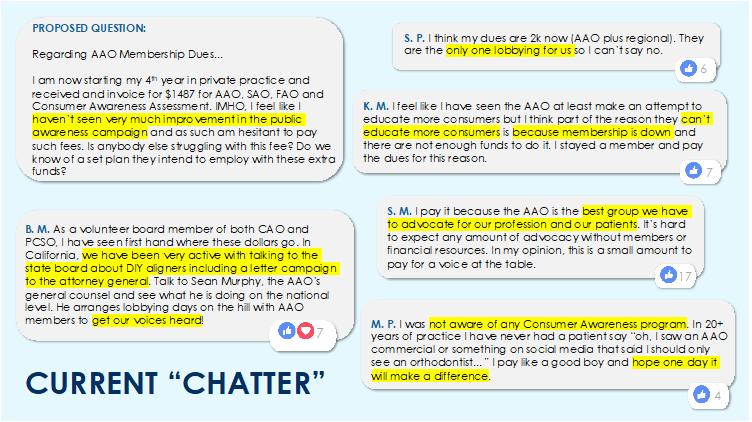Quarter 2
June 2020
Awareness Program (CAP) and Career Services. The main reasons these members maintain their memberships are the AAOendorsed Insurance Programs (AAOIC), the Annual Session continuing education, and the Legal Advocacy/Political Action Committee (PAC). When asked about the CAP directly, 70% of respondents report that the CAP is valuable; however, the perception of value for the CAP decreases with years in practice. When asked directly about the AAO-endorsed insurance programs, most respondents (73%+) reported that they value the AAOIC. This benefit is valued most by mid-career members (11-20 years), and members later in their career value this benefit the least (20+ years). When asked directly about the value of membership in organized orthodontics, most (70%+) respondents value membership as GoodExcellent. Furthermore, the perception of Good to Excellent value from membership increases with years in practice.
Chris Baker Eddy Sedeño Robin Mayo Arghavan Welch Wallie McCarlie Ahmad Abdelkarim Debbie Sema (EC Liaison)
• • • • • • •
RECOMMENDATIONS •
Find a way to efficiently and effectively ensure sure that every AAO member has access to the breakdown of how dues are spent.
•
Increase efforts to educate members about the benefits and results of CAP. This is a great benefit of AAO membership and should be promoted as such.
•
Members earlier in their careers may need additional assistance with dues and a way of enhancing their perception of the value of membership in the AAO.
•
Market/promote the VALUE OF MEMBERSHIP to the orthodontic residents and early (young) orthodontists.
•
In general, do not reduce fees for the purpose of increasing membership.
•
In general, continue to find ways to “stay relevant” in an ever-changing culture
REFERENCES (1) Mission and history, American Association of Orthodontists: https://www1.aaoinfo.org/ about-us/mission-history/. (2) “10 reasons to renew your AAO membership,” AAO: The Practice Management Bulletin, 2019; 37(3): 3-8. (3) Dunn, Dr Courtney. Does membership matter? The Progressive Orthodontist, Q2 2016; 78-79. www.orthopundit.com/doesmembership-matter/. (4) OrthoPreneurs (Facebook Private Group) August 26, 2019; Dr Nick Mann post
SAO Orange Team Leadership Project 2019
Patient Advocacy and Organized Dentistry: Identify the Issue and its Impact on Orthodontists As specialists in orthodontics, we are in a strong position to impact some of our fundamental responsibilities: to educate patients and to improve patient care. We can do these things individually. We can also do them collectively by being an active participant in organized dentistry. The mission of organized dentistry and of organized orthodontics is to advocate for patient-centered orthodontic care. Therefore, orthodontists and dentists have the legal, ethical, and moral duty to seek and advocate for treatment modalities that are in the best interest of patients.
There are currently a number of dental service organizations that seek to provide patients options to self-managed orthodontic care or do-it-yourself (DIY) orthodontics. These dental service organizations are located throughout the United States and successfully reach millions of consumers through marketing and promises to cut the “middle man”. These organizations follow several telemodels already adopted in retail, travel, dining, entertainment, and banking. Through these telemodels, patients can
20
generate data from their own devices that can be immediately analyzed, graphed and shared. Challenges inherent to teledentistry that apply to DIY orthodontics are patient confidentiality, different standards of care across different states and deceptive marketing.1
DEFINITION OF ISSUES Teledentistry is a combination of telecommunications and dentistry delivered in order to provide care across








